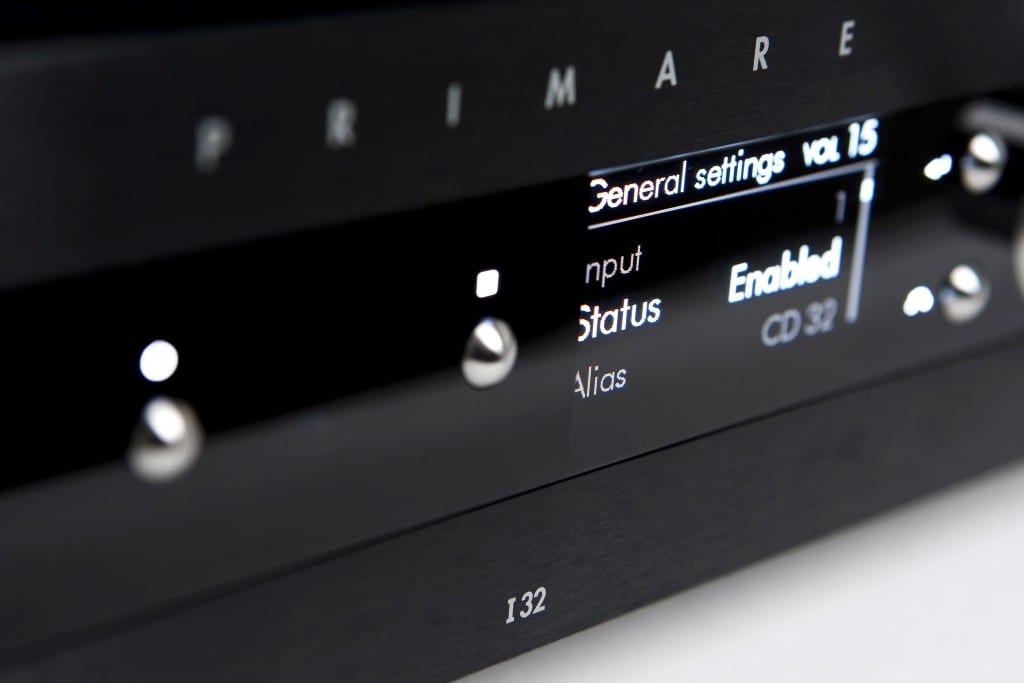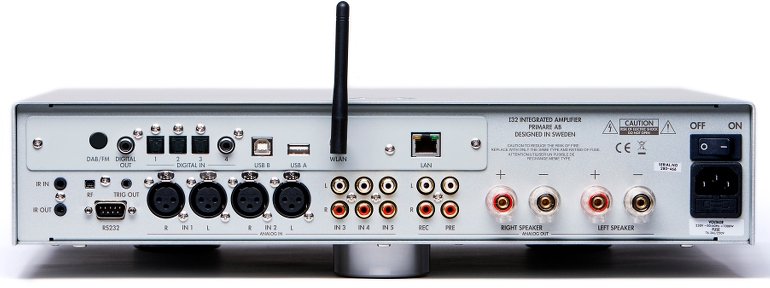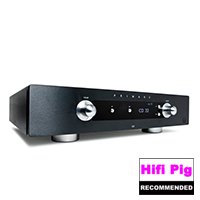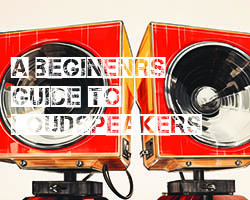Dan Worth takes a listen to this well specified integrated amplifier (£2000) complete with its MM30 Media board (£1250)
The I32 is an upgradable 2 x 120wpc integrated amplifier from Primare which with its modular design allows for users to upgrade with a Media Board to allow for network streaming, USB computer input and iPod USB inputs… along with coaxial and optical DAC inputs allowing for a truly flexible jack of all trades amplifier. Along with the optional Media Board the I32 supports MM/MC inputs, two balanced XLR analogue inputs and three RCA unbalanced inputs.
Two UFPD amplifiers are housed in the heavy gauge screened metal chassis. The preamplifier is a completely separate implementation which has is own isolated power supplies in order to reduce distortion levels and to allow for a cleaner feed to the power efficient Class D modules, which in standby only consume a meagre 0.2W of energy.
Primare have ensured their signal path design is as short as possible and all signal treatment (volume, source selection and balance trims) are processed purely in the analogue domain.
Unbalanced inputs are converted to balanced and buffered by the Burr Brown OPA2134 op-amps and routed to volume and balance controls employing closely matched LM1972 balanced stepped attenuators. Source switching is made via high quality relays.
ULTRA FAST POWER DEVICE CLASS-D AMPLIFIER
The use of switch mode power electronics is gaining in popularity as the result of its lower energy consumption and as a way to squeeze more amplifier channels into smaller spaces. Unfortunately Class D amplifiers and their switch mode power supplies have traditionally deserved a reputation for poor audio quality, characterised by rising THD with frequency. Primare’s UFPD (Ultra Fast Power Device) technology provides for the possibilities of a full-range ‘audiophile’ Class D design. It is a Class D technology which has a consistent 26dB feedback loop gain across the entire audio bandwidth and is stable way beyond the audible frequencies. This is quite easy to achieve in conventional linear ‘continuous signal’ amplifiers, but much more difficult in ‘non-continuous’ high speed switching amplifiers.
Rather than have the amplifier and then the filter as discrete stages, the UFPD design integrates the two, making control with feedback much more immediate and accurate. The UFPD amplifier actively adapts the loop gain to keep the total loop stable during start up, clipping and current limit. It senses the changes to the filter output and compensates by applying the precise amount of feedback. This adaptive pole control allows for several more dBs of constant loop gain across the audio band and maintains performance irrespective of load (impedance) variations.
Primare’s UFPD treats all signals equally regardless of frequency or slew rate and has the ability to suppress the filter resonance entirely. Consequently THD is kept very low at all frequencies. With a very wide ‘load independent’ frequency response UFPD is able to drive any speaker while maintaining control and accuracy.
Build quality is really nice with the thick front panel, heavy gauge chassis, powder coated and nice shiny, smart looking knobs and buttons on the fairly sparse (the way I like it) front panel. There’s a centrally aligned screen for display of source and volume, along with clear indication of muted playback. Although the rear of the unit is busy with many connecting sockets the layout is nicely grouped and organised.
The included remote control is packed full of buttons being a system remote for other linked Primare components – functional it is, but it’s nothing to write home about and is plasticky and lightweight, but hey-ho, it’s only a remote and I personally tend to never use them anyway – it screws up my daily exercise routine of having to get up and turn the volume knob by hand!
SOUND
After a good 40 minutes of warm up time the I32 really begins to kick into gear, producing fast, clean beats and a massive open and truly transparent midrange with an airy top-end which demands the listener’s attention. Up until the 40 minute mark point music sounds a little flat and noticeably slow.
Soundstage width is absolute magic with every nuance and micro detail being fully formed in all its robustness and clarity. Class D often leaves a lot to be desired when fleshing out notes with textural timbres and characterises itself all too often with leanness, limp bodied, sterile or cold taints, but the I32 is rich and full bodied in-between and beyond of the speakers. Tonal information is displayed in its full entirety regardless of image placement. For me, when I hear an amplifier which can reproduce full natural tones throughout the entire listening area, rather than suggestions of detail spread out, makes me instantly want to investigate the product further and adds a real first time excitement to the sound.
Although the richness of the sound signature replicates instruments and vocals incredibly well, the very lowest bass-line of the I32 takes a little getting used to. I’m used to having a slightly looser and gentler roll-off to the bottom end whereas the I32’s bass is full and tight, presenting more detail than say my Jeff Rowland integrated and has a tightness that is coupled with weight that defines the lowest notes further and more accurately. With the Rowland it colours the bottom end with a little bloom and allows for the lowest of registers to gently fade into the abyss – the I32 doesn’t suddenly stop or roll short in anyway, it has a point where the note ends, which after a little while of listening made me believe that it had a certain truthfulness about it. When playing upbeat music the I32 is so bouncy and musical it made me sad to revert to the Rowland, especially with the lively and energetic music I play during the daytime.
Listening in the later parts of the day to some Norah Jones allowed me to appreciate how transparent the sound is from this amplifier. Looking right through her vocal, each tender subtlety of her voice had as much prominence in the soundstage as the lightly rubbed strings to one side of the stage, imaging just outside of the left speaker and allowing it to disappear. I was offered up a timbre and naturalness that Class D in my experience simply doesn’t normally achieve. I have had the Rowland Class D pre and power for a while now and although tremendously good and better than the Primare in certain ways, just couldn’t expose details in such an uncoloured and effortless manner.
Top end again has such a completeness to it that when analysing it closely it’s very difficult to single it out completely and the overall cohesiveness of the amplifier draws you straight back into the full sound (and away from writing the review process!). Clarity, air and sparkle must be the key ‘buzz’ words for the I32’s treble performance, though I’d suggest that there is a very marginal and discrete decibel drop to finely align it with the rest of the frequency response. Notes are very concise and the response of the upper mid-range gives the treble body and thickness especially to strings and cymbals.
Listening to electronica with the I32 shows such pace in the treble as well as the entirety of the sound. Speed and timing seem to be really very accurate and bass notes dig really deep into what is a terrifically dark background.
Listening to Fink’s live album ‘The Wheels That Turn Beneath Me’ allowed for really insight again into the performance. The crowd’s applause was vast and wide and I’ve heard this album with a few pieces of equipment sounding a little nasal and congested or strangled, but the dynamic impact of the ultra fast transients which the I32 produces really gave some wallop and slam to the brisk, heavy, singular drum beats on ‘Perfect Darkness’.
CONCLUSION
I really could go on and on exploring and explaining my findings for track after track and I could have quite easily written this conclusion to say ‘If the Primare I32 is in your purchase budget and you require a new amp look no further’.
I would have loved to have some ATC’s here with this amp and after the review I will be experimenting and playing with other complementary kit as I just enjoyed the amp so much.
The I32 will take all your musical tastes and run wild with them. It’s not coloured or warm, it’s rich and vibrant, it’s not sterile or analytical, it’s clean and accurate. The I32 is fast, controlled and utterly poised, it won’t bite you if you give it some volume or listen to Spotify Premium with the High Quality button turned on and it won’t feel limp or lifeless when you want t listen to something more beautiful.
With dynamics that match the music and an effortlessness that is just so noticeably true, the I32 will remain a favourite for some time to come!
Sound Quality – 9.2/10
Value For Money – 8.8/10
Overall – 8.93/10
Dan Worth
Designer’s Comments
The I32 /MM30 combination marries the latest model in the line of 30 series integrated amps from Primare with digital-to-analogue conversion and streaming technologies. As a result of the modular design approach in the I32, the DAC and streaming capabilities, along with Bluetooth connectivity, can be easily added to the integrated amp by way of the MM30’s slide in board. This modular approach further allows for future upgrades to be taken advantage of as they arise.
The good stuff in the I32 includes our proprietary UFPD (Ultra-Fast Power Device) Class D amp modules. The term “Class D” is sometimes misunderstood as meaning a “Digital” amplifier.
While some Class D amps may indeed be controlled by digital circuits or include digital signal processing devices, Primare’s UFPD modules operate entirely in the analogue domain. Basically, the UFPD amplifier module takes an analogue input sine wave and converts it into a high frequency pulse width modulated square wave for amplification. This square wave is then filtered, resulting in an amplified analogue sine wave at the output.
In conjunction with UFPD, Primare uses an isolated PFC (Power Factor Control) technology in the power supply, which controls the current from the mains voltage so that it is a pure sine wave with the same frequency and phase as the mains voltage. This means that even if 1000W is taken from the mains, other equipment in the room will not be affected. Its presence becomes virtually invisible to the mains voltage! The isolating stage of the converter works in a ZVS mode and as a result, the switch flanks contain a lower quantity of harmonics, providing lower EMI and a clean environment for the amplifiers to work in.
The dual UFPD modules in the I32 are supported by an audiophile circuit topology involving an isolating heavy gauge alloy steel chassis and an isolated pre-amp section fed by a dedicated power supply.
The MM30 upgrade uses a SRC4392 sample rate converter in conjunction with a Burr Brown PCM1792 24/192 DAC, running continually at 24/192. Incoming data at rates other than 24/192 are up-sampled to 24/192 to ensure the optimal operation of the DAC. For reliable 24/192 operation, we’ve chosen XMOS because it offers an integrated communication hub hosting the MCU. Please note: 176.4kHz is not supported by XMOS on MM30 (176.4 is supported over network). Essentially the streaming/DAC topology is identical to that used by our £2K NP30 network player, so in the I32/MM30 you’re getting a great amp and player in one, for a great price.
Terry Medalen




















































































































































































































You must be logged in to leave a reply.